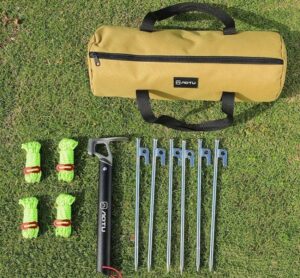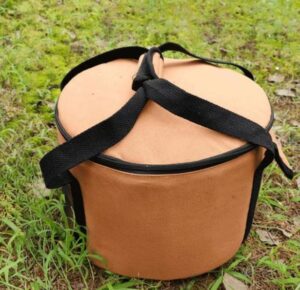Within the realm of outdoor adventure equipment, camping storage containers hold a pivotal role. For businesses catering to outdoor enthusiasts, a profound understanding of the meticulous process behind creating these containers, especially when fabric is the primary material, is paramount. In this article, we’ll unravel the intricacies of the manufacturing process, spotlighting key elements from a B2B perspective.

Camping storage containers, with fabric as their cornerstone material, undergo a thoughtful manufacturing process ensuring resilience, functionality, and cost-effectiveness for businesses.
Fabric Selection and Design
At the outset, manufacturers carefully select fabrics that align with the demands of outdoor usage. Heavy-duty, weather-resistant fabrics take center stage, complemented by designs that seamlessly marry aesthetics with practicality. This initial phase sets the foundation for a durable and visually appealing final product.
Cutting and Sewing Precision
The chosen fabric undergoes cutting and sewing processes where precision is paramount. Advanced cutting techniques ensure the perfect dimensions, while meticulous sewing guarantees the structural integrity of the containers. This is particularly crucial as fabric containers need to balance flexibility with robustness.
Assembly Line Efficiency
Streamlined assembly lines play a vital role in the production of fabric-centric camping storage containers. Each component, from the fabric panels to zippers and closures, is expertly integrated to optimize production efficiency while maintaining the high standards required for outdoor applications.
Quality Control Measures
Quality control measures are intensified, given the fabric-centric nature of these containers. Rigorous testing, including stress assessments, seam strength checks, and water resistance evaluations, ensures that every unit meets the stringent requirements of businesses in the outdoor sector.

As we delve deeper into the manufacturing process, the significance of fabric in crafting camping storage containers becomes apparent. Read on to uncover detailed insights into the specific steps involved and grasp how these fabric-centric containers evolve into reliable assets for your enterprise.
1: High-Performance Fabric Choices
The heart of fabric-centric containers lies in the choice of materials. High-performance fabrics, often incorporating polyester or nylon blends, offer durability, water resistance, and UV protection, catering to the demanding outdoor environment.
2: Precision Fabrication Techniques
Fabric panels are crafted with precision, ensuring they seamlessly come together during assembly. Laser cutting and computerized sewing techniques contribute to the exactness required for a snug and durable fit.
3: Reinforced Zippers and Closures
Recognizing the frequent use of these containers, especially the opening and closing mechanisms, special attention is given to zippers and closures. Reinforced designs and high-quality materials contribute to longevity and ease of operation.
4: Customization through Fabric
Fabric-centric containers present unique opportunities for customization. Brands can integrate specific colors, patterns, or even incorporate logos directly onto the fabric, strengthening their brand identity within the market.
5: Weather-Resistant Coating for Fabric
To enhance the fabric’s inherent properties, weather-resistant coatings are applied during the manufacturing process. This adds an extra layer of protection against the elements, ensuring the containers withstand diverse weather conditions.

In summary, the journey from fabric selection to the final quality checks in crafting camping storage containers underscores the commitment of the industry to providing durable, fabric-centric products. For B2B customers, comprehending this meticulous process is pivotal, allowing informed decisions that positively impact their outdoor ventures. As you contemplate integrating fabric-centric camping storage containers into your inventory, rest assured that the meticulous attention to detail ensures they meet and exceed the challenges posed by the great outdoors.


